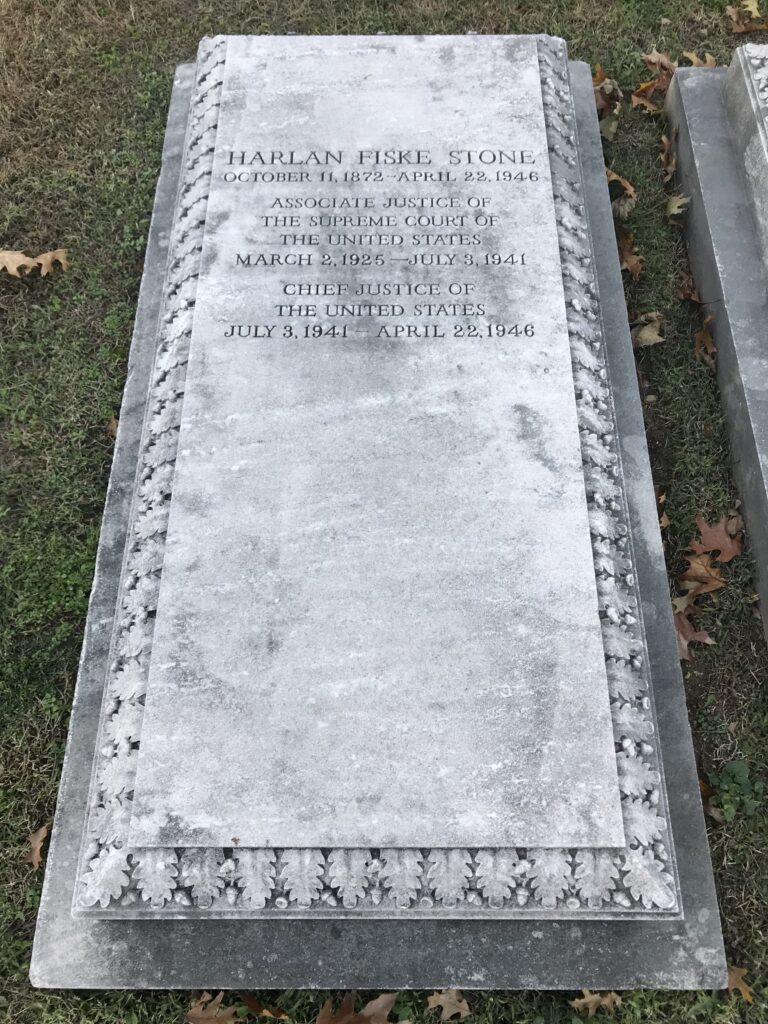Erik Visits an American Grave, Part 422
This is the grave of Harlan Stone.

Born in Chesterfield, New Hampshire in 1872, Stone graduated from Amherst College in 1894. He taught for a bit and then decided on law school, attending Columbia and both finishing his degree and passing the bar in 1898. He rose very fast in the law profession, showing great competence and gaining the respect of seemingly everyone. He started lecturing at the law school in 1899, while also practicing in the city. He was a professor there from 1902-05 and the dean from 1910-23. In between these stints, he was a partner at a firm.
Stone, a solid but unorthodox Republican, would sometimes take positions that seemed to undermine freedoms of people and other times support struggling people. An example of the former was during World War I, when he served on a judicial board reviewing conscientious objectors to fighting. He had absolutely no patience for these people, lecturing them on taking advantage of citizenship benefits without being willing to sacrifice for it. He did respect the toughness of the objectors, but usually did not support them. On the other hand, Stone protested when Attorney General A. Mitchell Palmer decided to use his power and the vacuum in the Oval Office thanks to the ill Woodrow Wilson to deport immigrant radicals without due process and engage in his infamous Palmer Raids, one of the worst violations of civil liberties by this government in the nation’s history.
Stone left Columbia in 1923 after a conflict with its famed president Nicholas Murray Butler and joined a firm on Wall Street. But he only lasted a year. That’s because Calvin Coolidge tapped his old friend and college classmate to the position of Attorney General. After the scandal-ridden Harding administration, Coolidge wanted someone very safe and incorruptible. Stone was a good choice on those grounds. One of the first things Stone did was fire every crony of his predecessor, the contemptible and corrupt Harry Daughtery. He helped establish the FBI as a permanent and professional organization with J. Edgar Hoover in charge; a regrettable decision, but remember that Hoover had pretty near universal support.
In 1925, Coolidge promoted Stone to the Supreme Court when Joseph McKenna stepped down. He was pretty easily confirmed, despite some concern about his Wall Street connections. There was every reason to think Stone would join the laissez-faire conservatives that dominated the Court. But he ended up being a sort of David Souter of his time. He became an ally of the small liberal faction, voting frequently with Brandeis and Holmes. The reason was that Stone strongly believed in judicial restraint and that the Court should largely defer to the legislature. That differed strongly with the Gilded Age mentality of overturning pretty much anything that smacked of reform, the sort of Court once again developing today. Stone became a major supporter of the New Deal, or at least its constitutionality. As the court-packing threat and delegitimization of the Court in the nation’s eyes forced the conservatives to step down after 1937, Stone’s power grew. He wrote the decision in the 1941 case U.S. v. Darby Lumber Company that upheld the Fair Labor Standards Act.
When Charles Evans Hughes stepped down as Chief Justice in 1941, FDR named Stone to replace him. He wasn’t a particularly important Chief Justice. He served only five years, dying in 1946. He voted, sadly, to uphold the government’s position in Korematsu. He also opposed the Nuremberg trials, evidently believing that they were not fair to the German defendants, even though his friend and colleague Robert Jackson was the leading prosecutor. In 1946, Stone was reading his dissent in Girouard v. U.S., a case that brought the justice all the way to his early career. Girouard was a Canadian pacifist applying for U.S. citizenship. The case was about whether someone who would refuse to fight for the nation should be granted citizenship. It was decided 5-3 in favor of the plantiff. Stone again disapproved of that, seeing the willingness to fight in war the ultimate determinant of citizenship in the body politic. He was reading his dissent, or perhaps he just finished it, accounts vary. While doing so, he fell ill. Hugo Black saw this and called for the adjournment of the Court. Stone died of a cerebral hemorrhage later that day.
Harlan Stone is buried in Rock Creek Cemetery, Washington, D.C.
If you would like this series to profile Stone’s colleagues on the Court, you can donate to cover the required expenses here. Owen Roberts is in West Vincent, Pennsylvania and Stanley Reed is in Maysville, Kentucky. Previous posts in this series are archived here.
